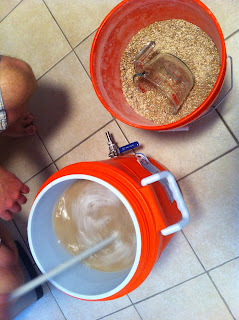Hi there,
Ok, ok...I'm really sorry
I've been bad with the updates lately
And I don't have any surgery/foot/
prescription drug related excuses this time
I just dropped the ball
Let me make it up to you!
We recently became involved in some of the
DC Homebrewers association activities. We went to our first event a few weeks ago at
Smith Commons where they did an all grain brew demonstration on the
premises. We learned a lot getting ready to go into our first all grain batch (see previous post...we will be brewing up a Fire Rock Clone). Everyone was really awesome and just plain loves beer. My kinda crowd.
We were able to pick everyone's brain and ask the important questions such as:
"Do you hate bottling as much as we do?",
"Do you prefer leaf or pellet hops?"
"What are the pros and cons of secondary conditioning?" and,
"Are you a ball lock or pin lock person" (apparently this means something in beer speak)
This information will be
imperative when it comes to our transition into both all-grain brewing, but kegging as well (which is something we are very close to doing).
This past weekend we visited a few of the local breweries. One up and comer is the
3 Stars Brewing Company. Located in the Tacoma area, they are not only a local brewery, but they are the district's FIRST AND ONLY homebrew shop! No more need to schlep out to the burbs for all your brewing needs! (there was much rejoicing)
The guys there are doing some amazing work. The space is awesome and the staff is extremely passionate and
knowledgeable. I cannot wait to try their beer. I have a feeling its going to be huge in the district. Best of luck to you guys!
In sticking with the DC beer theme, we decided to take a drive over to
DC Brau. There, we got to sample all of their latest offerings, got some beer swag, and of course, took home a growler full of the good stuff. We were particularly fond of their "Brainless Corruption", which was a belgian style pale ale and just the perfect way to spend a Saturday afternoon.
This weekend, we will be tweeting to you from SAVOR! (Follow us at @brewmeacoldone ... you know you wanna!) SAVOR week here in the district is full of fun beer-related events. If you are in the area, I would highly check out the list of events for the remainder of the week
here. For us, the main event is Saturday...which for me is basically an excuse to ignore doctor's orders, put on some heels, and drink a ton of craft brew =)
Our latest beer progress, kegging 101 and SAVOR posts coming soon















